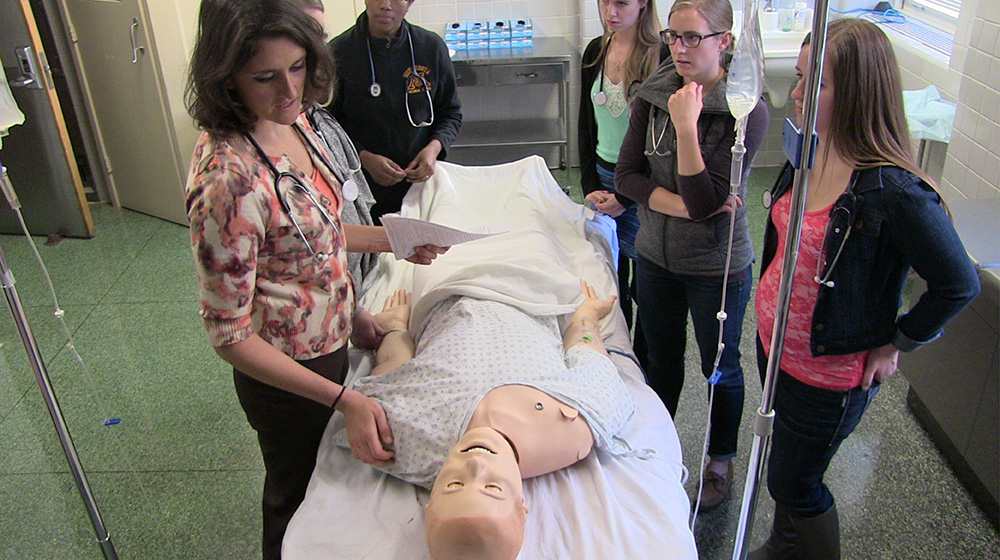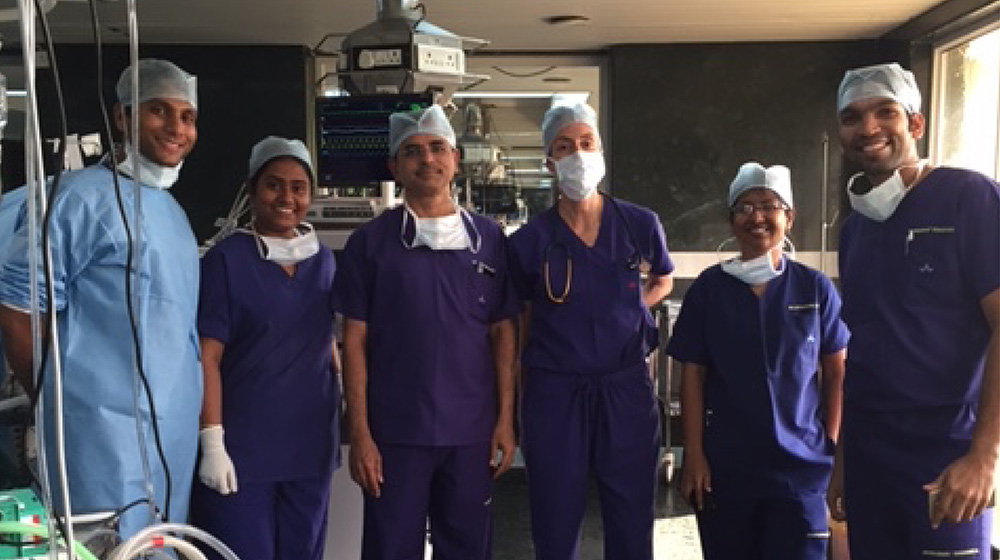Unique Program Aspects
Education & Training
Combined Pathway Program
The combined pathway program was developed to help residents early in their career to attain additional knowledge and skillsets that would enable them to become more competitive on a national level. Additional skill sets such as an MHA, MBA, or Masters in Education or Clinical Research would help create physician leaders and innovators to address the challenges in the field of Anesthesiology and healthcare in general.

M Simulation
Spring 2020, the University of Minnesota Simulation Center moved to its new home in the Health Sciences Education Center, a state-of-the-art facility designed to transform health education in Minnesota. The center spans the 5th and 6th floor of the building. Our very own Dr. Mojca Remskar is the medical director of the Simulation Center. The CA-1s and CA-2 & CA-3s have a separate simulation curriculum with multiple all-resident simulations such as difficult airway simulations and regional anesthesia simulations throughout the academic year.
Elective Opportunities
Not only do we provide experience and rotations in all domains of anesthesiology but we also have a wide range of elective opportunities including a rotation at our ambulatory surgery center, international experience and global health medicine, practice management rotation where our residents can learn how to effectively manage the OR schedule and board as well as practice supervising residents and CRNAs. We also have numerous teaching opportunities and the opportunity to create an education elective for those particularly interested in medical education.
Research Track
The American Board of Anesthesiology does allow time during the residency program to accommodate research for those residents who wish to embark on an academic research career. Currently, we work with individual residents and create programs that include mentoring, research time, resources, and courses that are tailored to their specific needs and interests. The intent is to provide residents with a skill set that would make them successful in a research-oriented career.
Clinical Experience
ICU Experience
At the University of Minnesota, we believe training in critical care is essential to being a strong anesthesiologist capable of caring for the sickest and most complicated of patients. Because of this, we have our residents do 6 total months total of critical care rotation (both SICU and CVICU) where many of our own faculty work as the intensivists in the unit. In fact, in the CVICU we only have anesthesiology trained intensivists leading our resident education and curriculum.
Didactic Time
We believe that our resident education should be protected both within and outside of the operating room. Not only do we ensure that our residents are a priority and their education never be compromised in the OR, but we also ensure they have protected didactic time which is why they are relieved from their OR duties at 3 pm daily in order to attend their didactic sessions including journal clubs, lectures, PBLDs, simulations, and more.
Role of CRNAs
We have an excellent relationship with the CRNAs in our department and function together as a team. The CRNAs ensure that all our trainees receive a morning and afternoon break from their clinical responsibilities as well as a 30 min lunch break every day. They also allow our residents to be relieved at 3 pm daily in order to ensure they can be present for their protected didactic time. We work with our CRNAs as a team when on call and they are also extremely helpful when it comes to learning the ins and outs of OR and out of OR set up and the locations of equipment and necessary devices.
Global Health
Dr. Zupfer is currently a faculty member who did her pediatric anesthesiology fellowship and anesthesiology residency at the University of Minnesota.

“As a pediatric anesthesia fellow, I traveled to India for a two-week rotation at Narayana Health, a multispecialty hospital located in 'Health City' on the outskirts of Bangalore. Pediatric patients come here from all over India and surrounding countries for advanced cardiac surgery. During my time in India I had the opportunity to work with 5 different pediatric cardiac surgeons, who performed up to 10 surgeries per day, collectively. In addition to participating in the anesthetic care of these patients, I joined the cardiac anesthesiology fellows for daily lectures on Transesophageal Echocardiography (TEE). In all, it was an amazing learning experience that I will never forget.”
Benefits
Food Allowance
Each resident involved in clinical duties will receive a Fairview meal card at the start of their CA1 academic year. The dollar amount will be determined by the number of call days the department designates to the resident.
Parking
The department currently provides contract parking for residents during their CA1 through CA3 year, on both the East and West Bank.
Recreation and Wellness Center
Located on the University of Minnesota’s East Bank Campus, the facility has equipment from cardio and weightlifting to lap swimming and rock climbing. The facility also hosts a wide range of other amenities.
Vacation & LOA
The American Board of Anesthesiology allows residents to take up to 60 days of sick/vacation/leave time over the course of their CA-1 through CA-2 year. We allow our residents to allocate 3 weeks of vacation and 1 week of sick leave per academic year.
Additional Leaves of Absence, beyond the 60 allowable days provided by the ABA, can be applied for on an as-needed basis. A resident who is becoming a parent through birth, adoption, gestational surrogacy or who is a gestational carrier may take up to 6 weeks of paid parental leave for every instance; this is a paid benefit for all trainees, which will not be deducted from other paid time away. The resident must give notice, in writing, of intent to use a leave of absence to their Program Director at least 8 weeks in advance, except under unusual circumstances. Notifying your Program Director and Program Coordinator as early as possible will be immensely beneficial to the program and the resident as it provides the time needed to create a coverage plan that maintains the important balance of education and service.
Stipend & Benefits
Please visit the University of Minnesota Applicants site for details on our stipends and benefits. A current Base Stipends chart can be viewed here (please note the year along the tabs at the bottom).
Academic/Conference stipend per year
Residents will receive $1000 per academic year (not including intern year) for educational and education-related travel expenses (carryover of unused funds will apply). Residents are allowed up to five (5) working days per AY to attend scientific meetings or conferences that will be counted as clinical time (resident must be a presenter).
ITE Incentive Policy
Resident academic achievement incentives policy.
- CA1: Rewarded an additional $750 education fund bonus if resident attains a scaled score equal to or above the 75th percentile on the basic component of the ABA in-training exam.
- CA2: Rewarded an additional $2,000 education fund bonus if resident attains a scaled score equal to or above the 75th percentile on the ABA in-training exam. Resident scaled scores above the 50th percentile will be awarded an additional $500 education fund bonus.
- All residents actively presenting (poster, oral presentations, etc.) at a major meeting will be allowed an additional $1,000 per year for travel expenses.
Residents are required to participate in MARC during their CA1 year. The department covers all conference expenses including registration, airfare, hotel, etc. (when in person conferences take place).